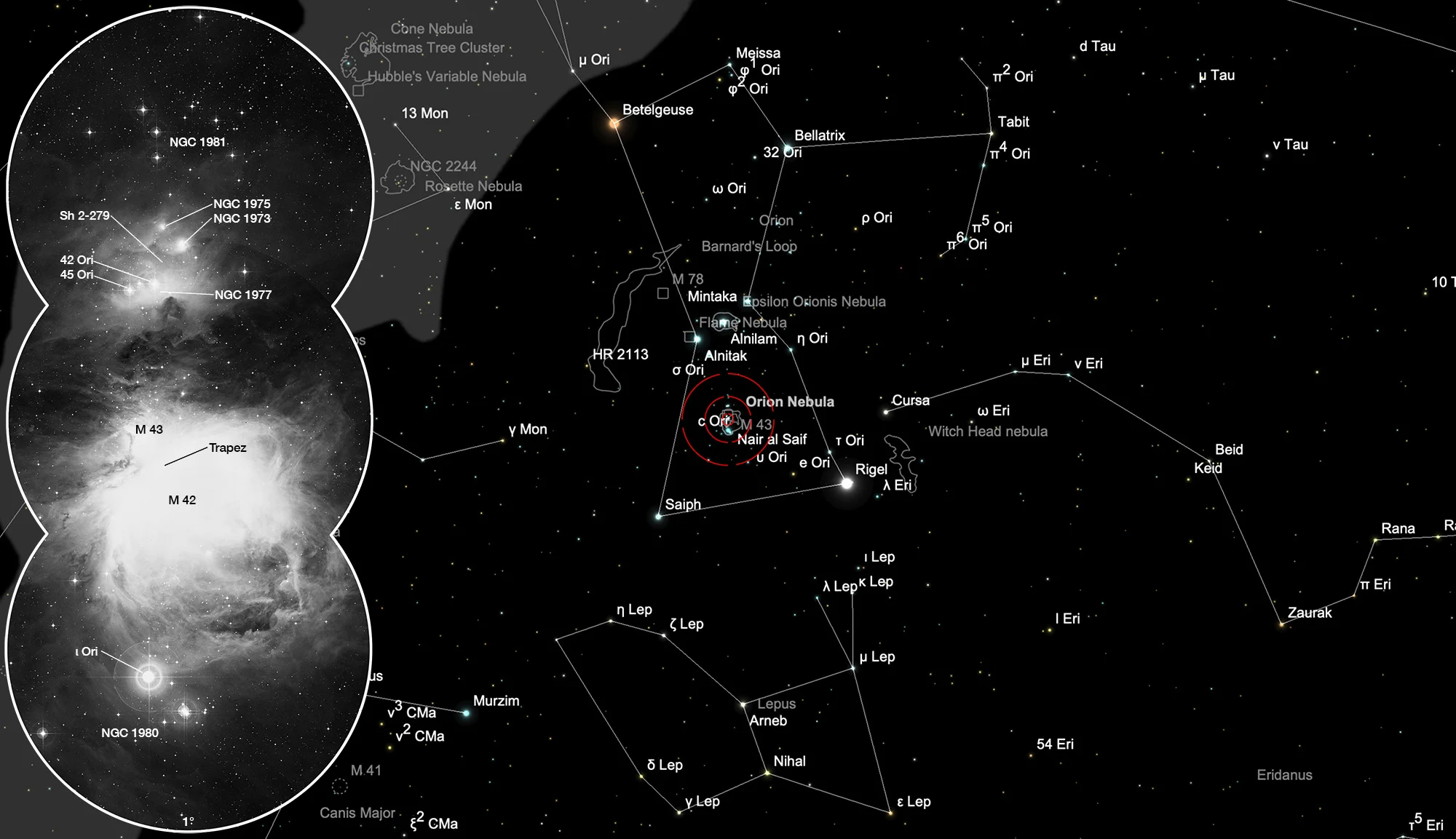Orion Nebula (Messier 42 )
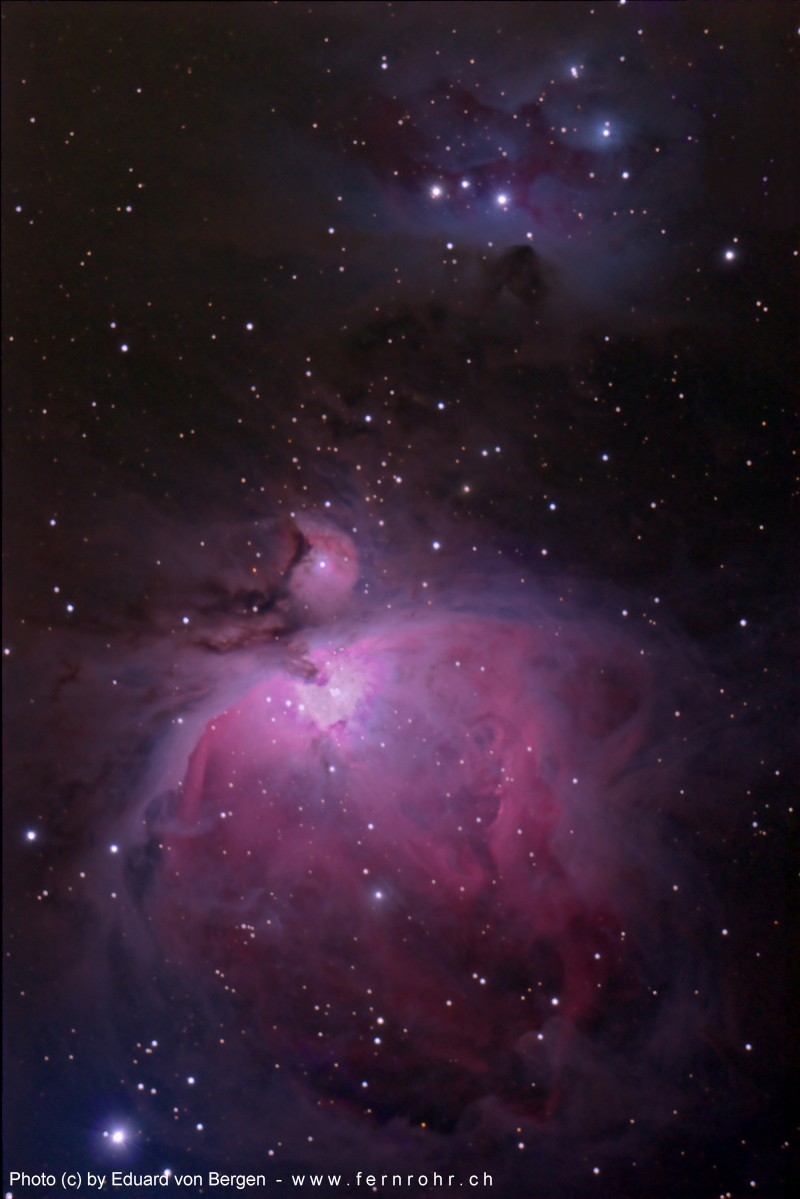
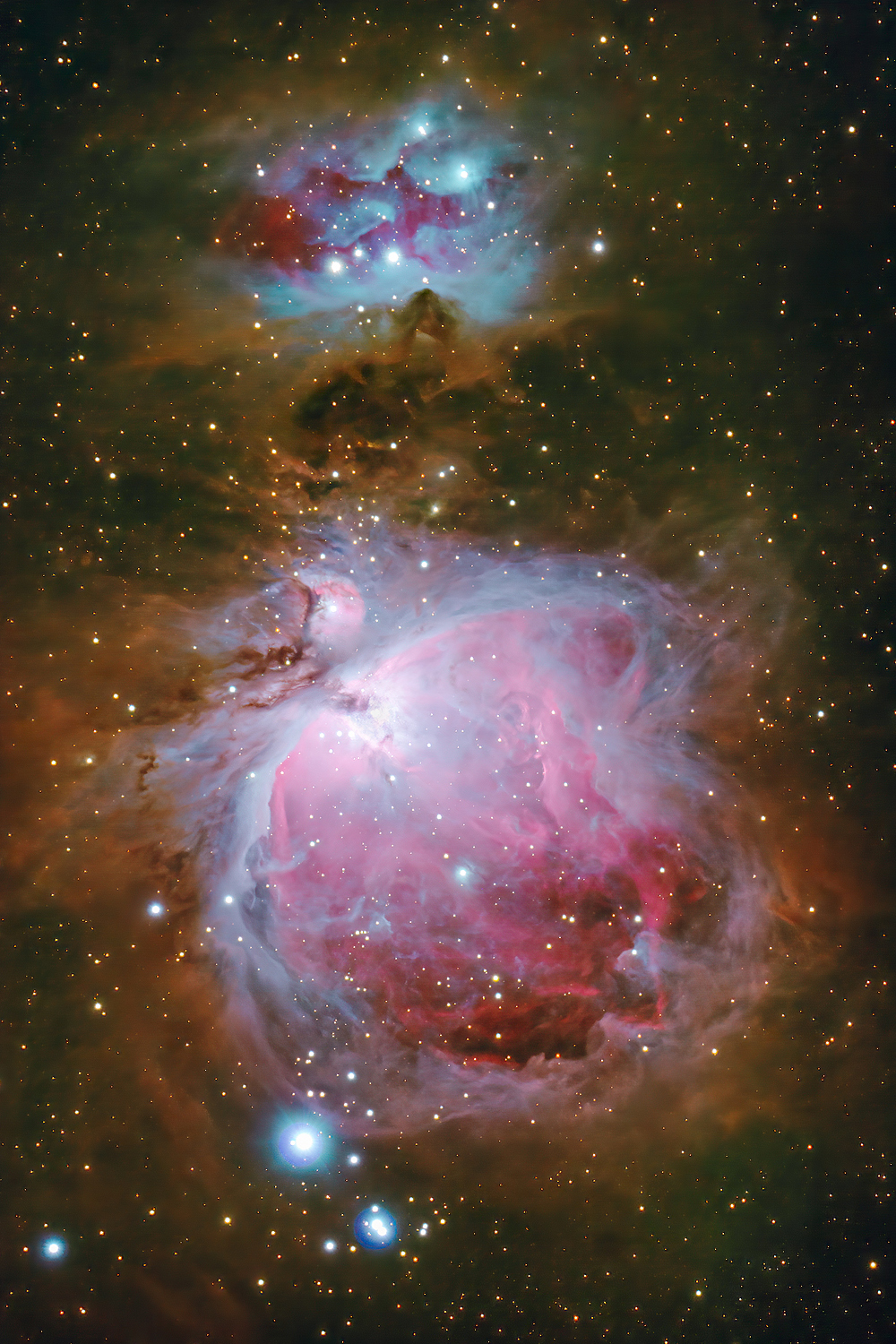
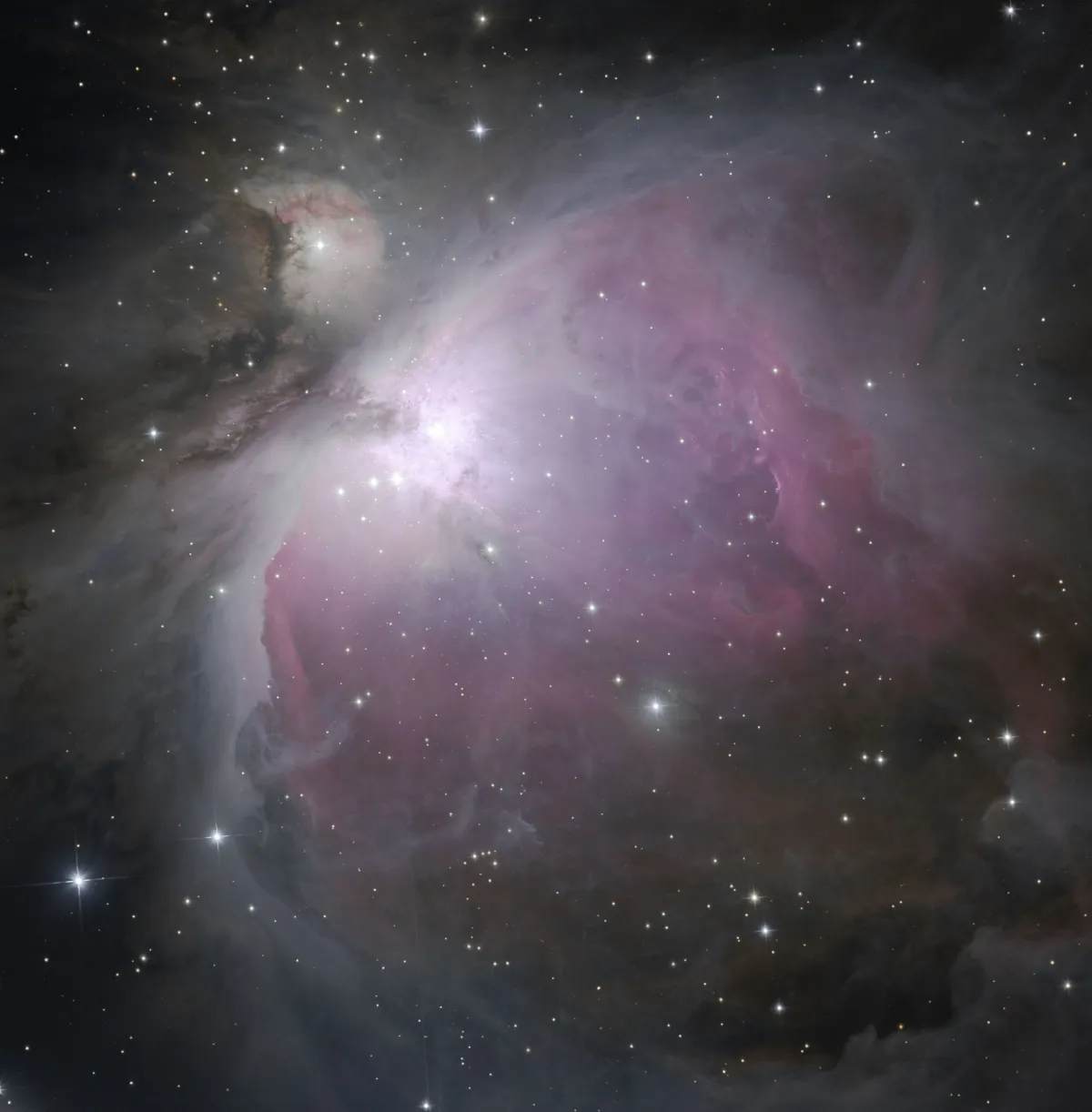
History
M 42, also called Orion Nebula, is probably one of the most beautiful and largest emission and partly also reflection nebulae in the sky and is located in the constellation Orion. Although it is visible to the naked eye as part of the sword, south of the three belt stars, it is not mentioned in either ancient or medieval records. Not even Galileo Galilei mentioned this nebula.
The discovery of the nebula is attributed to the French naturalist, astronomer and patron of science Nicolas-Claude Fabri de Peiresc in 1611. The next mention comes from the Swiss mathematician and astronomer Johann Baptist Cysat in 1618. He seemed to have mentioned the Orion Nebula mainly as a comparison to a comet that was visible at the time. The nebula remained comparatively unmentioned until 1656 Christian Huygens published the first drawing and description and drew attention to the remarkable multiple star θ Orionis in the middle of the bright nebula. [4]
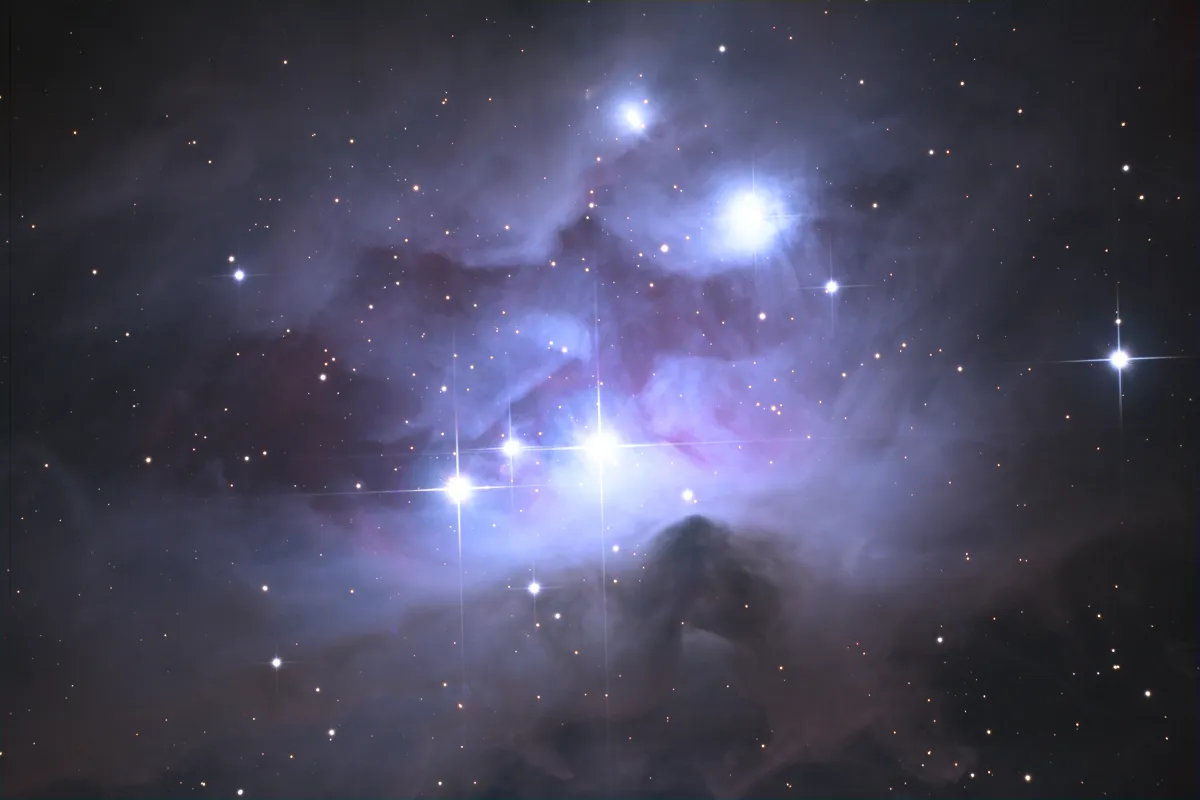
Charles Messier observed the nebula on 4 March 1769, cataloged it as number 42 on his list and wrote: «Position of the beautiful Orion's Sword Nebula, by the star theta contained therein along with three other smaller stars that can only be seen with good instruments. M. Messier has entered into great detail on this great nebula; he gave a drawing of it, made with the greatest care, which can be seen in the Memoirs of the Academy, year 1771, plance VIII. It was Huyghens who discovered it in 1656: it has since been observed by a large number of astronomers. Reported on the English Atlas.» [281] He also cataloged the small, nebula-shrouded star above M 42 as M 43.
William Herschel began his observer career in 1774 by observing the Orion Nebula in his self-constructed reflector telescope. The sight of it had fascinated him so much that he made observing such nebulae his life's work. [4]
Physical Properties
The Orion Nebula M 42 is about 1500 light years away in our immediate neighborhood. As shown in most photographs, it measures around 30 light years in diameter. The brightest central part is about 5-6 light years in size. Although the density of all the gas is less than a millionth of the best vacuum that can be created in a laboratory, there is enough material to form 10'000 stars with the mass of our sun. Long-exposure photos show that M 42 is only the brightest part of a gigantic molecular cloud complex that spreads across the entire constellation and is composed of luminous, reflective and dark clouds. The whole nebula complex is an active star formation area. Protoplanetary disks in the Orion Nebula can be discovered on images taken by the Hubble Space Telescope. [4, 145]
In addition to the M 42, the "Sword of Orion" also contains other deep-sky objects, which have their own NGC numbers in Dreyer's catalog. Compare location map Fig. 6: From north to south these are: open star cluster NGC 1981; Nebula NGC 1975; Nebula NGC 1977 with stars 42 and 45 Orionis; M 47 (NGC 1982) the northern tip of the Orion Nebula; M 42 (NGC 1976) the Orion Nebula itself with θ1 trapezoid; open star cluster NGC 1980 with star Nair al Saif (ι Orionis).
| Name | RA | Dec | Type | bMag | vMag | Dim | MD | Dreyer Description | Identification, Remarks |
|---|---|---|---|---|---|---|---|---|---|
| NGC 1973 | 05 35 04.8 | -04 43 55 | EN | 7.0 | 5 × 5 | 1.500 | * 8·9 inv in Neb (V 30) | GC 5352; CED 55B; part of N 1977 | |
| NGC 1975 | 05 35 18.0 | -04 41 00 | EN | 7.0 | 10 × 5 | 1.500 | B ** inv in neb (V 30) | GC 5353; CED 55C; part of N 1977 | |
| NGC 1976 | 05 35 17.1 | -05 23 25 | EN+RN | 3.7 | 4.0 | 40 × 35 | 0.412 | !!! Θ¹ Orionis and the great neb | h 360; GC 1179; M 42; LBN 974; Orion nebula |
| NGC 1977 | 05 35 18.0 | -04 49 15 | RN+OCL | 20 | 0.460 | !!, c¹ 42 Orionis and neb | WH V 30; GC 1180; OCL 525.1 | ||
| NGC 1980 | 05 35 25.0 | -05 54 54 | EN+OCL | 14 × 14 | 0.550 | vF, vvL, ι 44 Orionis inv | WH V 31; h 361; GC 1183; Iota Orionis Nebula; OCL 529 | ||
| NGC 1981 | 05 35 12.0 | -04 26 00 | OCL (III2p) | 4.2 | 28 | 0.400 | Cl, vB, lRi, st L, sc | h 362; GC 1184; OCL 525 | |
| NGC 1982 | 05 35 31.3 | -05 16 03 | EN | 6.8 | 20 × 15 | 0.400 | ! vB, vL, R with tail, mbM * 8·9 | GC 1185; M 43; CED 55G; Pos of CS |
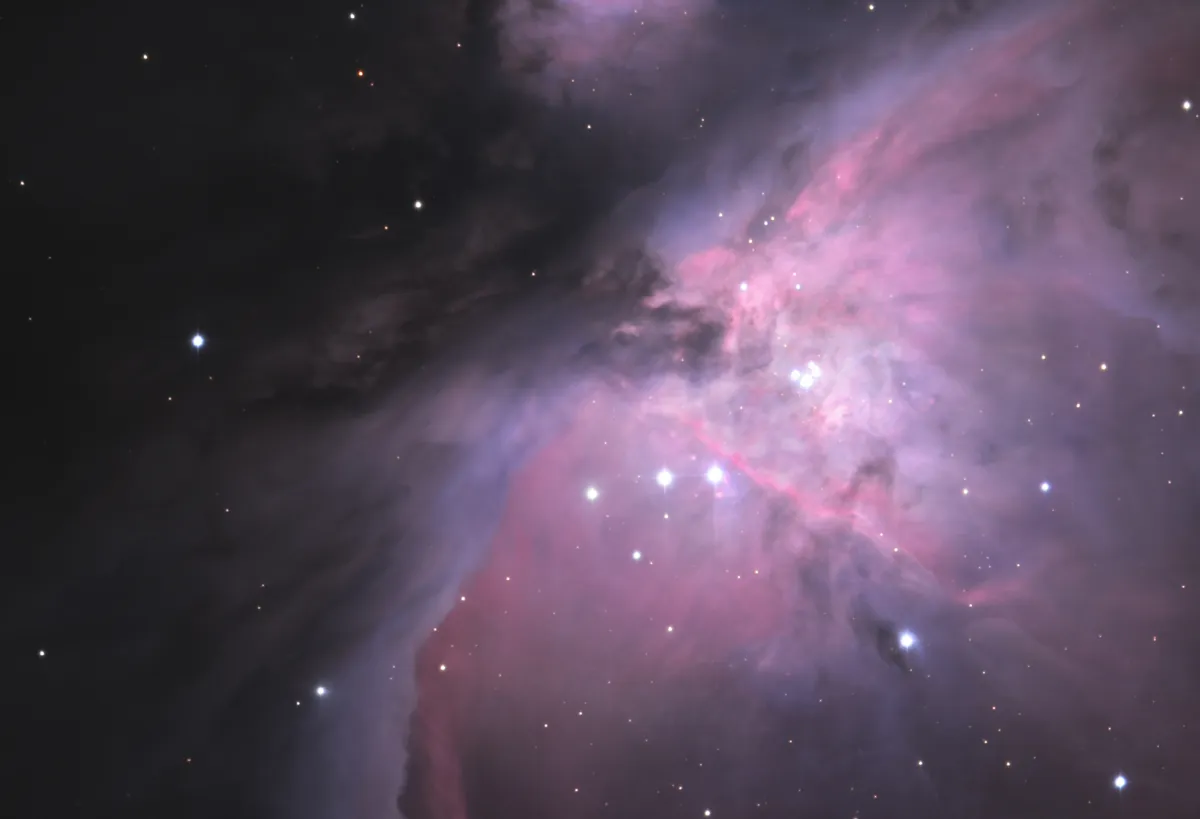
The Trapezium
A special jewel is located in the heart of M 42 and is at the same time the main source for the ionization of the glowing gas: the multiple star system θ1 Orionis, also 41 Orionis the «trapezium». The four corner stars of the trapezium form: θ1 Orionis A to D:
θ1 Orionis A (41 Orionis A, HD 37020, V1016 Orionis) is an eclipsing variable star. Every 65.4 days it briefly changes its brightness from 6.72 mag to 7.65 mag. It is a multiple star system with three known members. Components A1 and A2 are separated from each other by about 0.2 arc seconds (90 AU), while A1 itself is a double star whose companion at 1 AU distance could only be detected spectroscopically. [268]
θ1 Orionis B (41 Orionis B, HD 37021, BM Orionis) is an eclipsing variable star and changes its brightness every 6.47 days for 8-9 hours from 7.90 mag to 8.65 mag. Here, too, it is a question of a multiple star system with at least five members, four of which could be optically resolved. The brightest star is B1 while the companions are named B2, B3 and B4. B2 and B3 are only 0.1 arc seconds apart and the two are 0.9 arc seconds away from B1. B2 is about two magnitudes weaker than B2 and B3 is another magnitude. Between them, B4 is weaker with a distance of 0.6 arc seconds from B1 and five magnitudes. B1 is a hot star of the main sequence with the spectral type B1. The spectral class of its spectroscopic companion B5 is estimated at G2 III. [268]
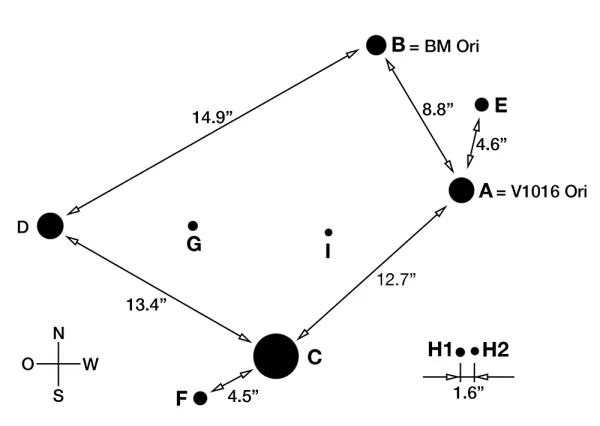
θ1 Orionis C (41 Orionis C, HD 37022) is the most massive of the trapezium stars. It is a blue giant with the spectral class O and has a companion of type B. Its brightness is 5.1 mag. It produces most of the UV light that makes the Orion Nebula glow. [268]
θ1 Orionis D (41 Orionis D, HD 37023) is a blue star of the main sequence with spectral class B and has several weaker companion stars. One of them is at a distance of 1.4 arc seconds. The other could only be detected spectroscopically and orbits it within 40 days. [268]
The magnitudes of the remaining θ1 Orionis components are: E = 10.3 mag, F = 10.2 mag, G = 14.5 mag, H1 = 14.5 mag, H2 = 15.5 mag, I = 15.0 mag.
More deep-sky objects that belong to the Orion molecular cloud are:
- Messier 43 (NGC 1982, northern part of Messier 42)
- NGC 1980 (open cluster, south of Messier 42)
- NGC 1981 (open cluster, north of Messier 42)
- NGC 1999: Cosmic Keyhole
- Horsehead Nebula (Barnard 33 in front of IC 434)
- NGC 2023: Lump star (reflection nebula around 7.82 mag star HD 37903)
- NGC 2024: Flaming Tree Nebula
- IC 435 (reflection nebula around 8.3 mag star HD 38087)
- Messier 78 (NGC 2068) mit NGC 2064, NGC 2067 und NGC 2071
- Barnard Loop (Sharpless 2-276)
- Witch Head Nebula (IC 2118)
- uvm.
Finder Chart
The Orion Nebula is located in Orion's Sword and is visible to the naked eye. Orion is a typical winter constellation and is best observed in the months of August to May.
Visual Observation
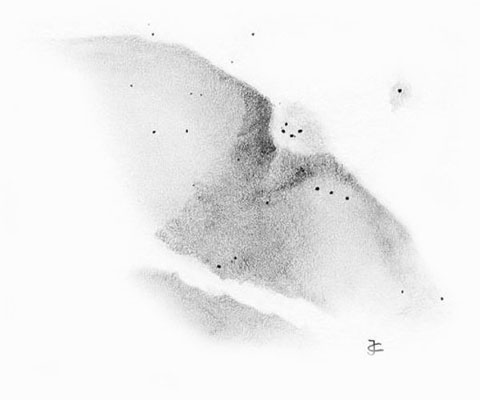
762 mm Aperture: The dark foreground cloud of M 42 clearly represents a structure in itself. In the lighter part, structures emerge that appear like fine pencil lines. The nebula appears three-dimensional and the bright wings of the nebula show themselves at the edge with a slightly reddish border. the light heart part, on the other hand, appears bluish. Above all, however, the majority of the M 43 is red. — 30" f/3.3 Slipstream Dobsonian, Hasliberg Reuti, 6. 11. 2021, Eduard von Bergen
762 mm Aperture: Since the Orion Nebula M 42 is almost upside down in the southwest, this results in a rather unusual perspective, with the black finger in the centre of the foreground and pointing from right to left. From it, a curvature — similar to a half-pipe — emerges towards the trapezoidal stars and the fish's mouth. Transverse to this are wing wings on both sides as extensions. The lowest point of all this lies in the trapezium, which appears in a bluish-greenish colour with the brightest part bordering it. The fringing parts of the nebula are slightly reddish in colour. — 30" SlipStream-Dobson f/3.3, Hasliberg, 26. 12. 2024, SQM-L 21.17, Eduard von Bergen
